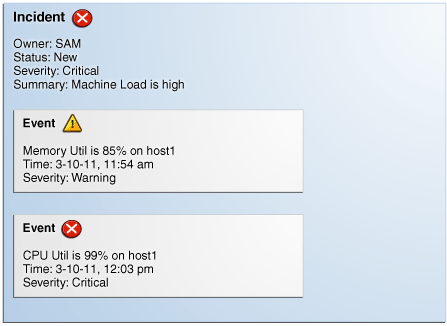Incident Composed of Multiple Events
Situations of interest may involve more than a single event. It is an incident's ability to contain multiple events that allows you to monitor and manage complex and more meaningful issues. These multi-event incidents can be automatically generated through event compression enabled at rule set level (see Rule-based Event Compression) or through global event compression policies enabled (see Event Compression Policies).
For example, if a monitored system is running out of space, separate multiple events such as tablespace full and filesystem full may be raised. Both, however, are related to running out of space. Another machine resource monitoring example might be the simultaneous raising of CPU utilization, memory utilization, and swap utilization events. Together, these events form an incident indicating extreme load is being placed on a monitored host. The following figure illustrates this example.
Figure 5-2 Incident with Multiple Events

Incidents inherit the worst severity of all the events within incident. The incident summary indicates why this incident should be of interest, in this case, "Machine Load is high". This message is an intuitive indicator for all administrators looking at this incident. By default, the incident summary is pulled from the message of the last event of the incident, however, this message can be changed by any administrator working on the incident.
Because administrators are interested in overall machine load, administrator Sam has an incident created for these two metric events because they are related—together these events represent a host overload situation. An administrator needs to take action because memory is filling up and consumed CPU resource is too high. In its current state, this condition will impact any applications running on the host.